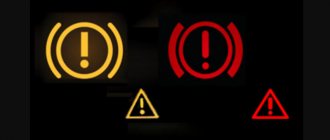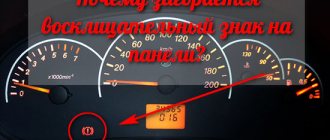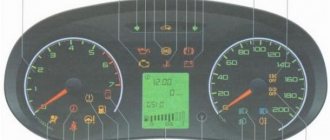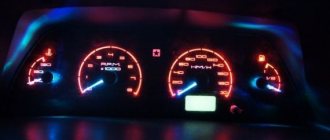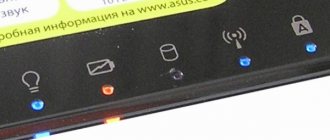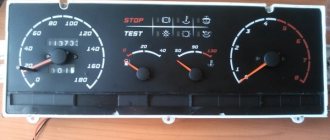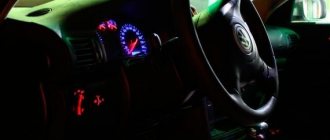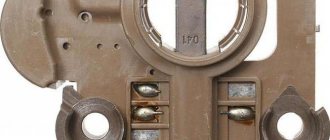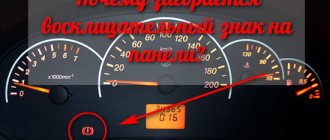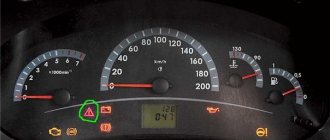April 10, 2017 Lada.Online 180 401 9
Currently, all LADA models (Lada XRAY, Vesta, Largus, Granta, Kalina, Priora, Niva 4×4) without exception are equipped with ABS (anti-lock braking system). During the operation of the car, many owners notice that the ABS and ESC lamps (if this system is available) light up on the instrument panel. Let's figure out how to solve this problem and improve the design.
What to do if the ABS light is on?
It is worth noting that the system works normally if the ABS icon lights up when the ignition is turned on and goes out after a couple of seconds. The first thing to do if the ABS light is constantly on is to check the fuse for this system, and also inspect the wheel sensors.
Quite often, the sensor connector on the hub either oxidizes or the wires fray. And if the ABS icon is on after replacing the pads or hub, then the first logical thought is that you forgot to connect the sensor connector. The presence of dirt on the sensor also causes the indicator to light up.
Quite often, car owners may be frightened by the appearance of an orange ABS icon after a good slip. In this case, you shouldn’t bother at all: brake sharply a couple of times and everything will go away on its own - the control unit’s normal reaction to such a situation. When the ABS light does not light up constantly, but periodically, then you need to inspect all the contacts, and most likely, the cause of the warning light can be quickly found and eliminated.
The exclamation mark is on - what to do?
We have noticed that new topics often pop up on car forums where drivers ask to put an exclamation mark on the Lada Priora dashboard. They rarely specify where the light is on and what is shown on the icon. In this section we have collected a small FAQ. Listed below are all the exclamation marks that can light up on the instrument cluster of a VAZ 2170 car. The designations of these icons are as follows:
- The red exclamation point in the circle (below) is lit. The indicator indicates a malfunction in the vehicle's brake system. This is usually a low brake fluid level. Add it to the tank and most likely the sign will stop lighting. If this does not happen, it is worth checking the system for damaged components. After turning on, the indicator turns on for 4 seconds, then goes off.
- The red exclamation point in the triangle/circle (above) is lit. In modern versions, a triangle is used instead of a circle. The indicator informs us about malfunctions in the operation of the brake force distributor. Be especially careful if lights are on while driving.
- Exclamation mark next to the steering wheel icon. A long glow indicates a malfunction of the electric power steering (EPS). Like the other icons, it turns on when you turn it on and turns off after a few seconds if the system is working normally.
Sometimes the indication is caused by faults in the electronics. Terminals, oxidation of contacts, defects in the on-board computer disappear - these are several reasons for the random appearance of icons. To avoid damaging one of the systems, check the electronics first. To do this, simply disassemble the cover on the Lada Priora and see if the terminals are tightly inserted into the sockets. If the brake system light comes on, first check the fluid level in the reservoir and only then add new antifreeze.
ABS fault detection
The serviceability of the ABS system in the Priora, like in any car, is a very important issue. It is very convenient that the slightest malfunction in its operation will immediately be reflected on the dashboard. The ABS warning light will come on or it will not go out after the required time after turning on the ignition.
There's no need to think twice about it. You urgently need to go for computer diagnostics to a decent service station. Modern Priora ABS ECUs have access to a diagnostic connector. They are perfectly diagnosed by both portable portable scanners and stationary motor testers. Since all ABS electronics are very closely connected with the mechanical part, most breakdowns in this area can be determined by an experienced diagnostician by scanning the ECU.
For example, the operating valve is jammed in one of the directions. What happens: the coil, figuratively speaking, tries to influence him, but he doesn’t move. The computer, noticing a load violation in the circuit, will immediately give a signal. The “ABS sensor” will light up. When connected, the technician will see the direction that needs to be looked at and quickly fix the problem.
Features of diagnostics of ABS Priora
Some scanners that read faults recorded in the ECU produce only alphanumeric codes, so for particularly meticulous car enthusiasts it makes sense to have on hand the decoding of these codes for the VAZ Priora:
- C0035 - malfunction of the left front sensor;
- C0040 – the same for the front right;
- C0045 – rear left malfunction;
- C0050 – the same for the right rear;
- C0060 – failure of the left front exhaust valve;
- C0065 – front left intake valve failure;
- C0070 – malfunction of the front right exhaust valve;
- C0075 – malfunction of the front right intake valve;
- C0080 – rear left exhaust;
- C0085 – rear left inlet;
- C0090 – rear right exhaust;
- C0095 – rear right intake valve;
- C0110 – return pump circuit malfunction;
- C0121 – failure in the relay circuit for turning on the supply voltage of the valves;
- C0161 – malfunction in the brake light circuit;
- C0245 – incorrect reading of rotation speed;
- C0550 - ECU malfunction;
- C0800 - voltage mismatch in the ABS network.
This list allows you to find a fault, even if a simple scanner for a Priora produces only codes, and find out why the “ABS sensor came on.” Still, it is worth remembering that it will be more pleasant for the technician to hear the correct wording - the anti-lock system malfunction lamp is on.
ABS control unit
Location of brake system elements with ABS on a car
| 1 – brake system high pressure line pipe; 2 – brake pedal; 3 – main brake cylinder; 4 – additional tank; 5 – vacuum brake booster; 6 – hydraulic control unit (HCU); | 7 – front disc brake mechanism; 8 – caliper; 9 – rear drum brake mechanism; 10 – parking brake lever; 11 – parking brake cable. |
When the rotor teeth pass near the sensor, the magnetic field of the sensor changes, resulting in a voltage pulse being generated. This voltage is proportional to the wheel speed and can be measured. Speed sensor
The speed sensor detects the rotation of the wheel and consists of a permanent magnet and a coil. Front wheel sensors receive information from geared rotors located on the drive shafts.
ABS warning lamp: The ABS and EBD warning lamps are located in the instrument cluster.
1)
Lights up for 3 seconds after turning on the ignition and then goes out.
2)
Goes off when the engine starts.
3)
If the lamp is constantly on, it means there is a problem with the ABS.
4)
The lamp is on during self-diagnosis.
5)
If the warning light lights up periodically, it means there are problems with the ABS and the vehicle systems operate as if the vehicle does not have ABS and TCS systems.
6)
The lamp lights up when the electrical connector is disconnected from the control unit
ECU. EBD (Electronic Brake Force Distribution) warning light:
1)
Lights up after turning on the ignition.
2)
Goes off when the engine starts.
3)
Lights up when the parking brake lever is applied.
4)
Lights up when the brake fluid level is low.
5)
Lights up if the electronic brake force distribution EBD does not work: – if there is a malfunction in the solenoid valve; – if there is a malfunction in more than one sensor; – if the ECU control unit is faulty; – when the voltage is exceeded.
Hydraulic Control Unit (HCU)
The Hydraulic Control Unit (HCU) consists of an electric motor pump and a valve block to control the ABS pressure. The sensor is located in the pump motor and transmits an output signal to the ABS unit, which determines the performance of the pump.
Front brake fluid pipe hole diameter: 4.8 mm Rear brake fluid pipe hole diameter: 4.8 mm
A dual-circuit pump provides the required pressure, and a valve block distributes the pressure transmitted to the wheel brakes.
| A – front right inlet valve; B – rear left inlet valve; C – rear right inlet valve; D – front left inlet valve; E – front right exhaust valve; F – rear left exhaust valve; G – rear right exhaust valve; H – front left exhaust valve; M – + engine; N – motor (GND). |
ABS self-diagnosis
The ABS control unit begins to perform self-diagnostic functions after turning on the ignition. The ABS control module detects faults for each circuit and component by comparing the system condition to a limited set of conditions in the ABS control module. The ABS control unit stores the fault code and then displays it to the scan tool as four-digit codes.
Checking Self-Diagnostic Codes
| EXECUTION ORDER |
| 1. Turn the ignition key to the OFF position and connect the scan tool to the scan connector located near the vacuum booster in the engine compartment. |
| 2. Turn the ignition key to the ON position and set the vehicle model and diagnostic tool model on the device. |
| 3. Select the parameter to be tested after the block is initialized. |
| 4. Press check codes #1 and find out if a fault is recorded. |
| Warning The fault code is a four-digit number that appears continuously until the fault code is cleared by the diagnostic tool. |
| 5. Using the list of fault codes, identify the faulty element and restore its functionality. |
| 6. After erasing the fault codes from the memory of the ABS control unit, select inspection point No. 4. |
Reasons for ABS system failure and what to do
Water getting into the contacts of the ABS control unit
We find the system control unit under the hood. It usually looks like a rectangular iron box with several metal tubes. There may be five or four of them. This is the anti-lock braking system unit. The power and control connector is connected to it - a large plug, it only fits the case, you won’t get it mixed up.
Disconnect the negative terminal of the battery and disconnect this connector from the ABS control unit. We check its contacts for moisture or mechanical damage. There were cases when they rotted and were destroyed by age and water, despite the moisture-proof casing of the connector. It may be damaged, allowing water to penetrate inside.
What to do
If you find moisture inside, blow and dry the plug and contacts both on it and on the control unit. If there is visible damage to the contacts of the plug, only replace it; if there is visible damage to the contacts of the ABS computer, then contact specialists who can replace the connector.
Fuse box
This is the simplest thing that a simple driver can check on his own if the ABS light comes on. It is advisable to check them first - this is the easiest way. We wipe our hands and climb under the hood, looking for a mounting block - a plastic box with fuses and relays.
Open it and turn over the top cover. It usually says where and what fuses are located in the block. We find the inscription “ABS” and according to the diagram we look for the fuse that is responsible for this system.
What to do
Checking the fuse. Usually there should be spare fuses in the mounting block if the machine is completely new. If there are none, then you can use the adjacent fuse. For example, remove a fan, horn, or other less important systems that were definitely working from the power socket. And insert in place of the old ABS fuse.
If the light goes out, then it's time to change it. Do not forget to return the “neighbor” to its place, otherwise the fan or other equipment from which the fuse was removed will not work.
Mud and snow
Further verification becomes a little more complicated. The sensors are located on the wheel hubs. Snow or dirt may stick between them and the gear, also called the ABS ring. They stop reading the rotation speed, and the ABS error light comes on.
Sometimes water gets into this gap between the sensor and the ring. The readings will no longer be sent to the control unit, and an error will appear on the instrument panel.
What to do
Cleaning it yourself will be problematic, but it is possible. We remove the sensor and inspect the ring teeth and its seat for frequency. Clean if necessary. If there is snow or water, then after a long trip the light should go out. If it continues to burn, then proceed to the next stage of testing.
Sensor wires
They are often rubbed by wheels or turning mechanisms. Because they are located next to the rotating elements of the chassis. The fasteners on them may break, the wiring will dangle, touching everything.
Over time, the insulation of wires and connectors may dry out. A short circuit occurs to the vehicle body. This also causes an ABS error.
What to do
Since we have already jacked up the car, let's inspect these wires. As I said, the sensors are screwed into or attached to the hubs of each wheel. Therefore, you need to inspect all four separately.
Wires can reach one meter. Your task is to examine them entirely. They may have abrasions, microcracks and other damage. The contact caps may also be torn. If you find any wiring defects, replace them; the ABS light should go out.
ABS sensors
They may get damaged. Chips stick to them - “work-out” from the gear rings. The contacts on the connector connecting the wire to the sensor may become oxidized. This will result in a poor connection. The control unit does not “see” the sensor in the system and will display an error on the dashboard.
What to do
If it is possible to unscrew the sensors from the hubs yourself, visually check their condition. We clear away any shavings, if any. If there is damage, we replace the sensor.
Remove the caps for connecting the wiring to the sensors. We check for oxidation and contact integrity. If they are green, we clean them from oxides; if they are destroyed, we change the wire with the connector or the sensor.
Causes of ABS error
The main possible reasons for a constantly burning ABS light on the dashboard:
After inspection and, it would seem, elimination of the cause, it is very easy to check the operation of the ABS; you just need to accelerate to 40 km and brake sharply - the vibration of the pedal will make itself felt and the icon will go out.
If a simple inspection for damage in the sensor circuit to the unit does not reveal anything, then diagnostics will be needed to determine the specific error code for the anti-lock brake system. On cars where an on-board computer is installed, this task is simplified; you just need to clearly understand the decoding of the code and where the problem could arise.
ABS is the first and most common active vehicle safety system. In Europe, mandatory ABS equipment for manufactured models is legally established, so it is not surprising that even cars belonging to the budget category are equipped with it. But in such cars it is almost the only one; in versions of the middle and premium categories, the number of such systems is large, and many of the additional systems are built on ABC.
ABS device on Priora
Like most modern car systems, ABS is computer controlled. But in addition to the electronic control unit, it also includes several sensors and actuators. The entire system consists of several elements.
- Electronic control unit (ECU).
- Sensors on wheel hubs 4 pcs.
- Brake fluid pressure valves in the system 4 pcs.
- EVN (Electric Return Pump).
- Warning light on the instrument panel.
Despite all its apparent simplicity, this is a rather complex, high-tech system. Each sensor transmits data on the rotation speed of the Priora wheel to the electronic control unit. Based on the data received, the control unit sends a signal to the brake system valve, which, when you press the brake pedal, releasing pressure, prevents the wheels from completely locking and starting an uncontrolled skid of the car.
Anti-lock brake control unit in hydraulic unit
Structurally, on the Priora, the ABS ECU is mounted together with the EWH and valves that regulate the pressure into a single unit - the hydraulic unit. It is located on the front left side member of the vehicle. The hydraulic unit is connected to the entire system by a common wiring harness. It includes pipes for supplying brake fluid to the working cylinders. An EWH is also installed here, increasing the pressure in the system.
Attention! This unit does not understand handicraft conditions. Usually replaced entirely with a new one.
Wheel hub sensor
The sensors that supply wheel speed data to the control unit are made on the principle of a Hall sensor. By the way, most rotation sensors use exactly this principle: changing the voltage on the semiconductor of the sensor, depending on the passage of a control point on the rotating disk near it. It is in correlation with the signals from the ABS sensors that the control unit manipulates the valves.
ABS malfunction warning lamp on the Priora instrument panel
What Priora drivers talk about – “the ABS sensor has come on” – is in fact a warning lamp for the serviceability of the anti-lock system. When the ignition is turned on, the orange “ABS” inscription will light up on the dashboard for about three seconds. If the system is working properly, then after three to four seconds the light will go out. In general, the principle of signaling from the “ABS sensor” is the same as from the warning lamp of the main ECU of the car, the well-known “check anger”.
How ABC works
The anti-lock braking system was developed when it became clear that when the wheels suddenly jam, the car loses stability and is difficult to control. Moreover, the quality of braking did not improve, and the car was pretty much carried off the road. Therefore, a system was developed that, by regulating the pressure in the brake system pipes, allows the wheels to turn slightly. This significantly improves vehicle dynamics, allowing the driver to control the vehicle more confidently. But despite its apparent simplicity, this is a rather complex process that requires the coordinated operation of many mechanisms included in the anti-lock braking system. If any of the components fails, a warning lamp lights up on the instrument panel.
You can often hear the question from drivers: “Why is the ABS sensor on?” It is important to know that when the warning light comes on, it does not necessarily indicate a faulty wheel sensor.
Behavior of a car with and without ABS
As you can see in the pictures, how a car behaves with a working ABS and a non-working one or without ABS. During a slide, ABS helps leave control of the car in the hands of the driver; without ABS, the car behaves in the direction the inertial force pushes it.
Why pneumatic
Communities Lada Priora Lada Priora Club Blog Ignition switch wires
Braking requires quite a lot of effort from the driver. Making such an “injection” and bleeding the brakes on four wheels at once is not an easy task. Therefore, a solution was found: due to the vacuum in the intake system, a special mechanism, a vacuum, greatly facilitates this process. And the pedal is quite easy to press.
Important! It is the system, operating on the “syringe” principle, with many rubber seals, that requires the complete absence of air in the system, since its presence reduces the efficiency of the brakes to zero.
Simply put, due to the difference in the density of air and brake fluid, instead of uniform pressure on the piston of the working cylinder, there will be a chaotic movement of air bubbles inside the system. Because of this, they sometimes need to be pumped.
The need to replace the device
Malfunctions in the ABS system are indicated by a warning lamp located on the dashboard of the car. In normal mode, the indicator lights up when the engine starts and goes out after 3–5 seconds. If the controller behaves incorrectly - it turns on while the engine is running or blinks chaotically when the car is moving - this is the first sign of a sensor failure.
The ABS indicator should go out 3-5 seconds after starting the engine
Also, a possible device malfunction is indicated by:
- an error code appears on the on-board computer display;
- continuous wheel locking during heavy braking;
- absence of characteristic vibration on the brake pedal when it is pressed;
- the parking brake indicator lamp has been activated when the handbrake is off.
If any of these problems occur, the device should be fully diagnosed. It is not at all necessary to trust this question to highly paid car service technicians - checking the ABS sensor yourself takes little time and is done without expensive equipment. If diagnostics reveal that the device is broken, it will have to be replaced with a new one.
What does the exclamation mark mean?
In the vast majority of cars, an exclamation point icon on the dashboard indicates a problem with the car's braking system. Often lights up along with an icon indicating the operation of the ABS system and vehicle stabilization system (if equipped). The appearance of these icons on the driver's dashboard indicates a possible malfunction of the brake system and unreliability of the brakes.
A malfunction in the car’s braking system is included in the list of malfunctions in which the operation of the car is prohibited by the “Road Rules”. In addition, the driver himself must be clear that driving with faulty brakes can lead to the most dire consequences.
If the icon lights up immediately after starting the engine, it is better for the driver to postpone the trip and start checking the car's braking system. If the icon lights up while driving, the driver needs to stop immediately and check the brake system.
Note. An exclamation point icon located "inside the tire" indicates low pressure in the vehicle's tires. If it appears on your dashboard, you need to check your tire pressure at your local tire store.
Replacing the ABS block
For repair you need to prepare:
- key "13";
- ratchet;
- head "10".
The procedure for working with Priora is as follows:
- Stop the car and raise it. Disconnect the minus from the battery.
- Drain the brake fluid from the cylinder brake hose.
- Unscrew the brake pipes connected to the block. There are 6 of them in total.
- Unhook the power lock and disconnect the wires.
- Unscrew the nuts fastening to the car body.
- Slowly pull the block and remove it.
- Install the unit by connecting everything in reverse order. Don't forget to bleed the brake system.
If two icons are lit, “exclamation mark” and ABS
Often there is a situation when two icons light up on the instrument cluster at the same time, for example, an “exclamation mark” and an ABS icon (or a stabilization system icon in the form of a “car on a curved road”).
Since a vehicle's braking system is often closely linked to the ABS (anti-lock braking system) and stability control system, if a malfunction occurs in one of these systems, the other may also stop working and/or be forcibly disconnected from the on-board computer. Therefore, if two icons appear on the instrument cluster at the same time, you will have to look for a fault in two systems at the same time.
If, after troubleshooting the brake system, the icons on the panel do not disappear, you will have to look for it in the ABS system (or stabilization system). However, it is worth mentioning that with a simple inspection it is very unlikely to detect a malfunction in the ABS or stabilization system, so if two icons appear at once, it is better to immediately contact a car service center. (or read only the errors).
Replacing the ABS sensor
To replace the anti-lock braking system sensor on a Priora, do the following:
- Raise the car. Hang up the wheel. The ideal position is on a car lift. First remove the negative terminal from the battery.
- The wheel behind which the faulty sensor “hides” is removed. To do this, working in a circle, smoothly, one by one, unscrew all the bolts and pull the wheel towards you.
- Behind the hub you will see the DSC mount: unscrew the screw that secures it using Torx T30.
- Disconnect the wiring harness.
- Replace the ABS sensor and reassemble everything in reverse order.
Is it possible to repair the sensor?
In the event of a malfunction, the device requires replacement (how to remove the ABS sensor was discussed above). Before starting work, contact your dealer and order a new part. After carrying out the work, test the device to ensure it is working properly. To do this, find a flat section of the road, accelerate the car to 30-40 kilometers per hour, and then sharply squeeze the brake.
If everything is done correctly, then impulses will be felt under your foot, and the car will stop. If the wiring is damaged, the latter must be replaced, and then diagnose the system using the algorithm already discussed.
Remember that if the sensor fails, it cannot be repaired. The only way out is replacement. What can be fixed is the wiring, which is changed or repaired with a soldering iron and electrical tape.
How the sensor works
Different manufacturers install different versions and implementations of anti-lock braking systems on their cars. There are several types of sensors. Some of them operate on the principle of the magnetoresistive effect, while others operate on the basis of the Hall effect. There are passive and active sensors.
Passive sensors are inductive speed sensors. The design and operating principle are extremely simple. It is based on an ordinary inductor coil wound using thin copper wire. A powerful magnet and an iron core are installed inside the coil - also magnetic. The end part of the coil with the core is installed opposite the magnetic ring mounted on the hub.
The sensor operates on the principle of electromagnetic induction. While the coil is at rest, there is no signal at the sensor outputs. When the car begins to move, a toothed ring rotor will move near the sensor core. This will change the magnetic field passing through the coil.
Due to the alternating magnetic field, an alternating current is generated in the coils, which is transmitted to the control unit. Such a system is not subject to interference and dirt, but begins to work only when the speed reaches 5-7 km/h.
An active analogue appeared in the 90s. The sensors operate on the principle of a semiconductor diode - the direction of the electric current changes under the influence of magnetic fields. Such sensors are called magnetoresistive. There is also a Hall effect sensor, where a current is generated in a resistor placed in a magnetic field.
The magnetic field is created by means of a special ring, which is attached to the car hub and rotates with the hub. In the case of passive sensors, any changes in the magnetic field lead to changes in the direction of the electrons - resulting in a change in resistance. These changes in resistance are recorded by the electronic module or ECU.
Why did the ABC light come on?
Video: The ABS light is on on the instrument panel. The brake lights do not go off.
As already noted, breakdowns occur in the electronic component, which includes sensors installed on the wheel hubs and the control unit. The mechanical component does not cause problems.
The “culprits” for the ABS warning light coming on:
Why the ABS fails can be easily identified by checking the listed components if the car is equipped with an on-board computer with a display on which error codes are displayed. This will significantly narrow down your search, since you can find out from the code which sensor is acting up.
In a car without an on-board computer display, to determine the malfunction, you will have to look for a scanner and connect it to the diagnostic connector to determine what caused the failure.
Note that identifying the error code will make the search easier, since diagnostics will not provide accurate information; it will indicate where to look for the fault. Therefore, you can even do without scanning.
ABS turns on randomly, the light blinks or lights up periodically
One of the most difficult forms of breakdowns is the constant blinking of the ABS light. This means that the anti-lock braking system sensors send incorrect signals to the computer, which, in turn, issues other incorrect commands to the vehicle's systems and modules. In such cases, many people prefer to simply turn off the anti-lock system, since unpleasant incidents may occur. For example, turning on ABS at a speed of 90 kilometers per hour with light braking can damage the chassis of the car and contribute to a complete loss of control over control. It's better to do this:
- bring the car to a service center for diagnostics, find out the reason for the chaotic operation of the equipment;
- for domestic cars equipped with a primitive anti-blocking device, it is better to immediately disable the system;
- complex designs and on-board electronic systems of foreign cars will have to be reflashed for repair;
- on some machines it will be easier to find the problem and fix it than to disable the anti-lock;
- you need to keep in mind that this particular system is not always the cause of the ABS light coming on; the problems can be different;
- During the diagnostic process, it is better to check the entire on-board electrical system and equipment.
By paying a certain amount for a car inspection, you can get the right answers to important questions. Sometimes a light that comes on on the panel can develop into a full-fledged repair of important units and components of the car, so you will have to spend a lot. But in most cases, this problem is not so expensive to solve. The cost of repair work depends, of course, on the make and model of the car, and on the price of spare parts. If an ABS sensor for a domestic car costs from 600 rubles, then a Japanese SUV will cost more than 10,000 rubles to replace one such sensor.
How to recognize that the ABS sensor is no longer performing its functions
On older cars, a malfunction of the ABS sensor can lead to the most unpleasant consequences. If the wire breaks, the voltage may not reach the computer, just like when the wheel is locked. Therefore, a simple computer assumes this situation is that one of the wheels is blocked. Ultimately, Abs begins to unlock one wheel during braking, which can completely disable the braking system, and during a critical stop, provoke a complete loss of control right before the car turns over. Signs that the ABS sensor is faulty are:
- after inadequate operation of the system, the message “Abs” appears on the dashboard, the module stops working;
- on modern cars, after starting the engine, the ABS light does not go out, and the system stops working;
- during weak braking, the pedal vibrates, the brake force dispersal system is activated;
- auxiliary brake systems, amplifiers and balancing devices operate constantly;
- the on-board vehicle displays a number of problems that are related to the operation of the anti-lock braking system;
- When connected to a diagnostic computer, an error code for the anti-wheel lock system sensor is read.
Without the help of others, you can find a sensor malfunction if the ABS light is constantly displayed on the dashboard. This is the main indicator that a certain sensor has stopped working and the system simply does not work. In this case, the first task of the motorist will be to check the integrity of the wires to the sensors. These wires often break due to stones thrown into the hub area or other objects that cut the wire. Therefore, this problem is not uncommon; virtually all owners of cars with this module know it.
What to do if the ABS system starts to work incorrectly and the indicator blinks?
This situation is one of the most complex system failures. The thing is that the sensors read incorrect information and transmit it to the control device, which for this reason gives incorrect commands to the actuators. Unfortunately, most vehicle owners, when detecting this malfunction, simply turn off the ABS system, since this is an effective measure to prevent serious consequences while driving. For example, spontaneous activation of the system while driving at a speed of more than 90 km/h can lead to serious damage to the suspension, which will provoke an emergency situation as a result of loss of control over the car. In this case, you need to do this:
- perform system diagnostics at a car service center;
- if the ABS system is installed on a domestic car, it must be disabled;
- it is quite possible that after repairing the ABS, the ECU will need to be reflashed, but this measure is applicable mainly for foreign cars;
- disabling the anti-lock system is not a solution to the problem, since on most vehicles its presence is simply necessary and is determined by the design features of their chassis, body and frame;
- You should not completely rule out the presence of faults in other components of the car that cause interruptions in the operation of the ABS.
It is necessary to remember that only diagnostics using special equipment will help to establish the real reason for the incorrect operation of the anti-lock system, which may lie in the malfunction of its components or other components of the vehicle. Therefore, you should be prepared for anything. But in many cases the problem can be solved quite simply. The cost of restoring the ABS system will depend only on its design and the make of the car. But the need to carry out this work is dictated by the safe operation of automotive equipment, the design of which includes such a system.
Problems caused by the ABS system cannot be called difficult to solve, but in any case they require immediate elimination. As you can see, the banal shutdown of the system, which most car owners consider a panacea in the event of a malfunction, is not always this magic remedy. All that needs to be done is to correctly identify the malfunction and eliminate it, because in most cases, it is not related to the functioning of the anti-lock system.
The abs sensor of a Priora car is placed near the wheels. It comes in front and back. The ABS unit is placed near the engine on the right, if you open the hood and stand in front of the car. When AbS (ABC) lights up on the panel, it means there is a problem with the system. Why do cars need this system? Abs affects the braking of the car, Priora with this system brakes 2 times faster than without it. The wheels brake in small portions, measured by a computer. Initially in 2008 there were cars without it. Read the article to the end and find out what the error is, what it is responsible for and why the ABS lights up and does not work. Priora has sensors and an ABS unit. Failure of any spare part leads to problems. On the Prior, there are 18 errors belonging to the braking system.
The appearance of an icon on the dashboard indicates an error occurring in the operation of the vehicle. There are serious errors on the Priora, if they occur, you should not tempt fate and move on, but there are errors that can be postponed. For example, the ABS system is considered very valuable for a modern driver in a car.
The Priora's ABS system saves you during unexpected and sudden braking and makes the process itself more efficient, reducing the braking distance. Therefore, when the ABS light is on on the Priora’s dashboard, strange feelings of uncertainty arise - knowing that the road situation can be so unpredictable that you will have to brake sharply, you involuntarily have to look for the reason why the icon appeared on the dashboard.
As in many systems, this behavior of the car's control unit may result in the ABS sensor on the Priora having to be replaced. A large system with a fairly simple device is worth checking - for your own safety.
ABS error
Good luck to everyone, I haven’t checked in here for a long time) There’s not much to say on the topic - since the beginning of the year, I’ve been bothered by a recurring ABS error on bumps when braking. I have a Chinese ELM 327 - it does not pick up ABS errors. In general, for the last month the error was constantly on and I decided (for the first time in my life) to go to an authorized Lada-Detal service center for a 500-ruble diagnosis) They made a diagnosis - error C0110
pump fault error. They also offered to change the ABS unit + installation + bleeding of brakes + brake fluid for 15,000 rubles - I almost went crazy from such prices! All they can do is perform unit repairs, the devils! I drove into the garage and went on the Internet to look for the truth about collective farm adventures) from the first link, a colleague on the drive was already fooling around with this error and, on his advice, I decided to crawl under the hood and look at the fuse box near the battery. By the way, I changed the battery in September - instead of the factory one, Akom chose a Westa so that it would at least resemble Vesta under the hood)
So, to our knowledge - I gutted the fuse box near the battery, it came off easily, there was little dust
And here is the same 40A fuse, which also powers the ABS unit - one contact has burned out, albeit weakly
In the end, I cleaned it up, inserted it with my feet in the opposite direction and voila - there was no error for a week no matter how much bumps I slowed down)
Source
Why does the ABS light even come on?
In a normally running vehicle, this indicator shows you that the wheels have been unlocked. In this case, everything works fine, the sensors sensed the need to turn on the safety system, initiated its operation and demonstrated to the driver that some assistance was provided when braking. When you see the ABS light on while braking, it is better to release the brake pedal a little and take over control of the car. If you have an expensive, high-tech car, you can trust the well-thought-out systems and let ABS+EBD do the job. In other cases, the light may be on for the following reasons:
- the sensors are clogged, the on-board computer indicates that the diagnostic error code should be read;
- Dirt or rust got on the sensors, which caused the anti-lock braking system to turn on incorrectly;
- there is a problem in the on-board electrical system, which is demonstrated by random lights coming on;
- the wheel bearing has failed, which forces the sensors to constantly turn on the anti-lock braking system by mistake;
- the fuses in the unit responsible for the ABS system have failed and are passing the signal directly;
- There was an error in the computer that caused the ABS light to come on.
Also, sometimes troubles occur with the generator and other elements of the machine’s electrical circuit, which can result in the lighting of the diagnostic system light or warning lights of any type. For example, on a Volkswagen car produced in the 2000s, the anti-lock braking system light comes on even if there is an error in completely different components. Therefore, self-diagnosis is only a partially acceptable method of solving the problem, because often the driver does not have special tools at hand for a good investigation.
What can you check yourself if the ABS light comes on?
The first thing you can do yourself in such a situation is to go to a car wash and ask for a good wash of the wheels. Often this intensive high pressure wash will clean the ABS sensors near the brake rotors. On the way to the car wash, you can do another simple test. Accelerate to a speed of 80-90km/h, close the windows and turn off the music. If you hear a slight or annoying hum in the wheel area (front or rear) in this driving mode, the likely cause of the light is a wheel bearing failure. There are many more things you can do:
- inspect the fuse box and replace the module responsible for the operation of the anti-lock braking system;
- If possible, read the diagnostic trouble code and read it on forums;
- to a specialist, describing your situation, and then try to correct the error yourself;
- autonomously reach the ABS sensors by jacking up the car and removing the wheels, make sure they are clean;
- inspect the electronic control unit under the hood, check that there is no liquid in it or on it;
- the best solution is to go to a service station and pay for diagnostics of the car's anti-lock and electric braking systems.
The last step will probably be the most correct, since you will receive a clear answer to your questions, you will be able to determine the repair budget and the presence of serious problems. This is the only way to completely get rid of problems with a burning diagnostic lamp and other unusual ways of handling the car. Simply connect computer diagnostics to the advanced program and check the machine for possible errors. In a few minutes you will receive the necessary information and can begin to solve the problem yourself or professionally.
Why does the indicator on the instrument panel light up?
If the ABS light comes on on the dashboard, the reasons for this may be the following:
- It lights up every time the car engine starts - this is how the system signals that it is in working condition. If the system is fully operational, the light should go out after some time. If the ABS light does not light up when you start the engine, the indicator is most likely faulty.
- If the light does not go out for a long time, this means that there are problems in the ABS system. The on-board computer, detecting errors, generates a failure code, saves it and turns on the warning indicator.
Dashboard indicator symbols
When starting up, almost all the order icons light up: this checks the operation of the light bulbs. Some drivers believe that these are messages regarding malfunctions of any Lada Priora system.
| not on the diagram | Indicator symbols |
| 1 | Speedometer. The device measures the crankshaft speed (revolutions per minute). If the arrow exceeds the red value, it means that the Lada Priora engine is operating dangerously; |
| 2 | Brake force distributor indicator. Report malfunctions in the operation of this unit; |
| 3 | Charger. If the light comes on while the engine is running, the battery is discharged; |
| 4 | Left Turn Signal. The icon flashes when there is an alarm or the left indicator is on; |
| 5 | Speedometer. The device signals the speed at which your Lada Priora is currently moving; |
| 6 | Emergency lubricant pressure in the engine. If the sign is on when the control unit is operating, the pressure in the system is low, it is strictly not recommended to start the engine in this state; |
| 7 | Right turn signal (see No. 4); |
| eight | Handbrake indicator. Lights up yellow if Lada Priora is on the “handbrake”; |
| nine | Antifreeze temperature in the cooling system. The engine operating temperature starts from 90 ° and above to the red mark. In case of overheating, turn off the engine; |
| 10 | Fuel level in the tank. If the fuel level approaches the minimum level, the fuel pump may fail; |
| eleven | Reserve gasoline level. The light comes on when there are less than 10 liters left; |
| 12 | Button for resetting the daily mileage and switching between display modes; |
| 13 | Anxiety. If you have activated the emergency range, the warning light will flash along with the turn signal arrows; |
| 14 | Electrical booster malfunctions. If defects are detected in the EUR, the lamp will light up while the engine is running; |
| 15 | Designation of main beams. An active indicator indicates that you have switched to distant; |
| 16 | Outdoor Lighting. The system warns the driver about the operation of the headlights or low beams; |
| 17 | Airbag malfunctions. If the warning light comes on after starting, it is very likely that the airbags will not deploy in the event of a collision; |
| 18 | Immobilizer. One beep and one flash indicate a malfunction of the immobilizer system; |
| 19 | Computer screen. Here you can view information from the bookmaker, as well as find out the total and daily mileage; |
| winds | Identification of unfastened seat belts. The buzzer signals a violation for 90 seconds; |
| 21 years old | The brake system is in poor condition. Very often these are worn pads or insufficient fluid in the system; |
| 22 | Disabling a specific airbag; |
| 23 | ASB malfunction indicator, the brake system is operating normally; |
| 24 | Check the engine: the engine is faulty, diagnosis and subsequent repairs are urgent. |
Why does the ABS light come on?
Based on how the anti-lock braking system is designed, we can easily conclude that the lamp can be on for the following reasons:
- This could be a malfunction of ABS sensors installed near the wheels, damage to the electronic unit, or wiring. Problems with the crowns on the wheel hubs cannot be ruled out. Often, parts of the chassis may shift or change their position, as a result of which the position of the sensors is disrupted. The malfunction may also be caused by a blown fuse.
- On some models from VAG, which were produced in the late nineties, there is one feature that is associated with the inclusion of an ABS error signal, and the fault itself is located in another unit.
All of the above can lead to the ABS light coming on when the car is moving. For example, vibrations caused by an uneven road very often lead to a break in the wiring. When driving on bad roads or where there are no roads at all, the sensors may become covered with dirt and sand.
This will not allow them to transmit the correct information to the electronic unit and will cause the light to remain on.
In what cases is it necessary to remove the instrument panel?
Disassembly of a Priora order is necessary for tuning or replacing burnt out lamps. The VAZ 2170 is a modern model, so there are not many fastenings on the panel. For disassembly you will need a set of screwdrivers. Don't forget to turn off the minus battery.
The process begins with removing the mounting block. To do this, you need to slide the latches on the fuse cover and then disassemble it;
ABS sensor on the hub
The sensors that supply wheel speed data to the control unit are made on the principle of a Hall sensor. By the way, most rotation sensors use exactly this principle: changing the voltage on the semiconductor of the sensor, depending on the passage of a control point on the rotating disk near it. It is in correlation with the signals from the ABS sensors that the control unit manipulates the valves.
Standard sensor and ABS unit - article number and price
The anti-lock braking system operates the rear and front wheels. It contains several brackets, brackets, and other fasteners that ensure accurate operation of the ABS and hydraulic unit damper (article 11180353832400, price - about 30 rubles). But only three items are considered the main ones in ABS:
ABS control unit (“brain”) - article number 11180353801001, cost - about 10,000 rubles; Front wheel speed sensor - catalog number 11180353835000, cost - about 1,000 rubles; Rear wheel sensor - catalog number 11180353837000, cost - 1000-1200 rubles. Often, to solve the problem, you only need to buy an anti-lock sensor from Priora, so the scale of financial costs is not as huge as it seems at first.
How to repair wiring
We treat it with a special means for cleaning electrical contacts (for example, graphite grease) and clean the contacts from oxides. We clean the wheel speed sensor and the surface around the sensor from dirt.
Attention! Keep ABS sensors away from magnets as this may cause damage.
How to modify the design
To protect the wiring harness from the environment, you can use a D-shaped seal. We lay the wires in it and wrap it with electrical tape. We put everything in the corrugation. We glue the cover covering the ABS sensor connector around the perimeter with the same sealant. This will prevent moisture and dirt from entering the area where the sensor and connector are located.
Attention! If the ABS fails, the brakes remain operational, but the braking efficiency is reduced, which is especially dangerous on some surfaces. See why.
Share on social networks:
Found an error? Select it and press Ctrl+Enter..
Source
What to do in this case, how to measure the resistance?
As can be seen from the breakdown options discussed above, most of the problems are related specifically to the ABS sensor. In this case, information about the malfunction immediately manifests itself in the form of a warning lamp glowing.
ABS light came on
The question is how to check the ABS sensor without spending additional money and calling for service. All that is required to solve the problem is a combination device or multimeter, a car manual and wires with PIN connectors. If possible, use an assistant.
To check the resistance, switch the multimeter to ohmmeter mode, then proceed as follows:
- Use a lifting device (jack) to lift the machine.
- Remove the wheel if it restricts access to the sensor.
- Remove the screw that holds the device in place (it's easy to find at the back of the hub).
- Remove the housing that protects the control unit, and then remove the connectors through which power is supplied to the controllers.
- Insert wires with PIN connectors into the circuit, and then connect them with the sensor and multimeter.
- Measure the resistance and check the resulting parameter with what the car manufacturer recommends.
- Check the wires for continuity and short circuit.
Have a helper spin the wheel several times. At the same time, monitor and record resistance parameters. If the sensor is working properly, then during rotation the resistance indicator will change. The normal parameters are as follows (measurements are made in relation to the sensor):
- Leg device - 5-26 Ohm.
- Ground device - from 20 kOhm or more.
How to replace an ABS sensor at home
1. Remove the wheel, put the car on the handbrake, and install supports under the body.
2. Remove the “-” terminal of the battery or remove fuses F5 and F6 from the fuse block.
3. Treat the sensor and its mounting with WD-40.
4. Unscrew the sensor mounting bolt.
5. Disconnect the power connector.
6. Install a new ABS sensor and put everything back together. After assembly, check to see if the ABS fault indicator is on.
Some useful tips to avoid problems with ABS sensors
- Before disconnecting the sensors, always remove fuses F5, F6.
- When replacing wheel bearings, remove the ABS sensors.
- Install wheel bearings very carefully so as not to damage the magnetic ring. The bearing itself must fit clearly, without gaps or distortions, otherwise problems with the ABS sensor may occur.
- When repairing the chassis, make sure that the sensor wiring is securely insulated and does not come into contact with rubbing parts.
- From time to time, inspect the power wires, as well as the sensors themselves, for damage and breaks.
That's all for me, I hope this article will help you solve your problem. All the best and see you again at Ford Master.
Looking for a reason
You should start troubleshooting with the fuse. If this element burns out, the ABS does not work. Note that you should not always go into the fuse box, since the behavior of the system itself can give a “hint” regarding the serviceability of the fuse. For example, if the ABS light on the instrument panel comes on only under certain conditions, but after turning off the power to the ignition switch and restarting the engine, the problem disappears, then the problem is clearly not in the fuse. It should only be checked if the warning light is constantly on.
